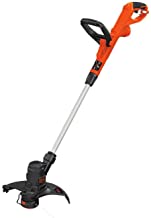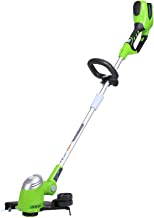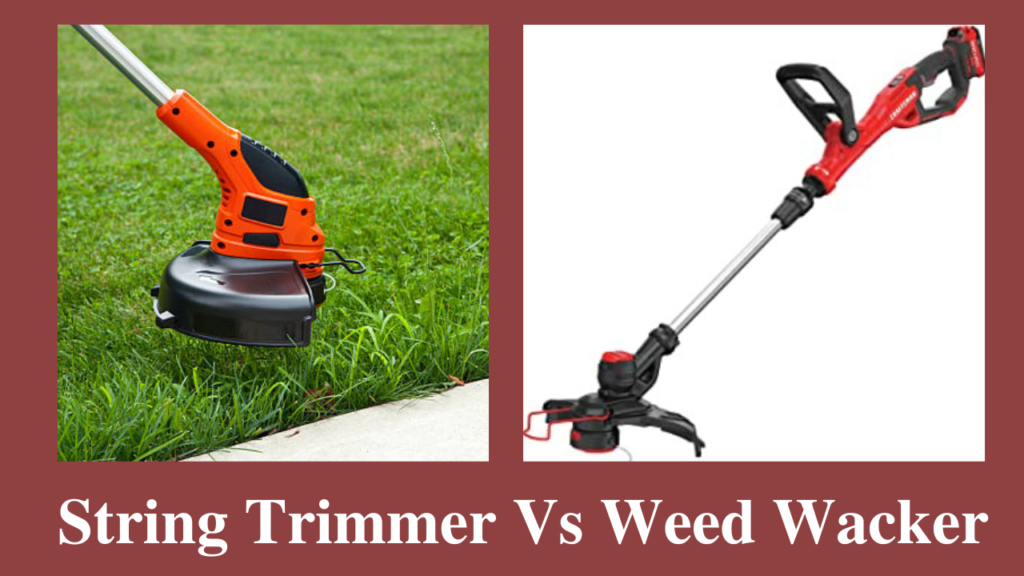string trimmer vs weed wacker are both names that can be used synonymously to refer to the same piece of gardening and landscaping equipment. This tool is utilized to trim grass, weeds, and bushes that grow in regions a lawn mower cannot reach. Other uses for this tool include: In some retail establishments, you could hear it referred to as a line trimmer or a string trimmer instead.
When considering a string trimmer vs weed wacker, it’s important to note that the word “weed eater” can also apply to “string trimmers,” a different kind of weed eater. String trimmers and other functionally equivalent devices can be used to cut the grass and the stems of other plants to the desired length. Weed Eater was the first company to bring a string trimmer to the market, and since then, it has grown to become the most recognized brand name in the string trimmer industry. It wasn’t until 1972 that a gadget called a Weed Eater was invented to make mowing lawns safer for individuals and more convenient for them to accomplish. Since then, string trimmers have become available from various manufacturers and in multiple designs.

What is the correct term for a person who uses a weed wacker or weed eater?
Sincerity requires me to acknowledge that this is a debatable topic! “String trimmer” is an acceptable alternative to the more specific term “weed wacker” when referring to this type of power tool. Weed whackers typically use monofilament or nylon line (or string). Therefore the fact that this is the case is logically consistent with the function of the tool. This is a great and uncomplicated name, but you won’t be able to recall it as fast as the term “weed eater.”
There are numerous variants of weed eaters, the most common of which are string trimmers and weed eaters. Weed eaters can come in a variety of other configurations.
1. Classification of Machining Tools for Cutting
It is often constructed for nylon and is employed to cut the string. To complete the plant cutting operation, the cutting head is hooked to the line, which is then spun at rates of several miles per hour. The thickness of the bar can be cut to a customer’s specifications, which is decided by the difficulty associated with the trimming process.
Similar in function to string trimmers weed wacker differ in that the cutting head of the former is outfitted with blades. Plastic blades are an alternative for cutting through the light layer of leaves, but as the density of the plant rises, it is more probable that metal blades will be necessary.
Establishment for the Generation of Electricity
Gas-powered trimmers can have either a 4-cycle or 2-cycle engine, with the 4-cycle engine being more powerful but also more extensive, noisier, and cumbersome. Electric string trimmers can be powered either by an electrical cord or batteries. Depending on the model, a gas-oil engine, wire, or battery provides the power for bladed trimmers. String trimmers get their energy from an electric motor.
Design
The engine is fastened to a long pole and at the end of the bar. This configuration for string trimmers is by far the most prevalent one. To avoid the lines coming into contact with the grime, they are held with two hands just above the ground surface. There is a diverse range of options available when shopping for bladed trimmers. The fundamental distinction between bladed trimmers, string trimmers, and weed wackers is that blades, rather than monofilament, serve as the cutting instrument in bladed trimmers. The bladed trimmer is equivalent considering string trimmer vs weed wacker. To name just two examples, other trimmers that include edges include edgers and brush cutters. These instruments often include two wheels at the base of the shaft, near the blade area. This enables the operator to roll blades precisely over the plant without causing any damage to it. Because their primary function is to trim the grass along the edge of a pathway or driveway, edger blades are almost always arranged vertically.
Purpose
When cutting around obstacles such as trees, stones, and other barriers where a blade should not be used, string trimmers are an excellent tool to have on hand and are highly recommended. Users can now trim the grass around trees without inflicting any damage to the bark of the trees, thanks to the Weed Eater brand, which was developed to make this possible. Although string trimmers are capable of cutting an entire lawn, their primary application is in regions that a lawnmower is unable to reach or in places that are extremely difficult to access.
Typically, the bladed trimmer is used for jobs and cutting particularly dense plants. Other typical applications include pruning hedges and cutting grass. As you move closer to the concrete, you should use the blades to make a cut that is both thin and exact.

The consistency of the Slicing Instrument’s Performance
The monofilament lines typically used with string trimmers wear down because of their constant use. Spools of a line can be purchased at stores in order to replace a cord that has been frayed. This line can replace the line that was previously used.
Metal is a more durable material than plastic or line, so blades made of metal should be your first choice. There is a potential that the blades’ metal will chip if they are struck repeatedly on stone or concrete. Honing is possible for metal blades, but they need to replace if there are any apparent fractures or chips on the surface.
FAQs
1. The essential distinctions between the string trimmer and the bladder trimmer
To make cuts through the grass, that is cycled through the device at a high pace. Instead of the more traditional manner of utilizing the blades, bladed trimmers use blades made of plastic or metal instead.
2. Is it risky to operate a string trimmer close to rocks, tree roots, or other vegetation types?
When trimming around obstacles such as boulders and trees, string trimmers can do so with greater precision than bladed trimmers. Utilizing bladed trimmers for jobs such as cutting through dense vegetation and edging around concrete are two examples of activities that considerably benefit from having this capability. The efficiency of a bladed trimmer is superior to that of a string trimmer in most scenarios; nevertheless, it is not as safe to operate near rocks, tree roots, or other vegetation.

